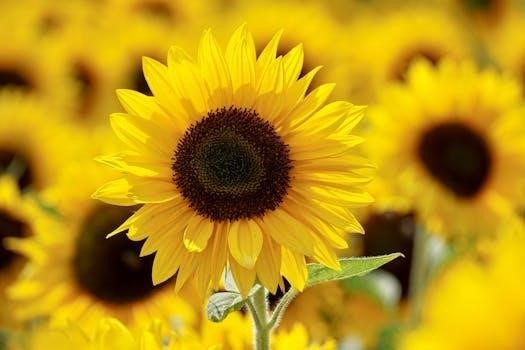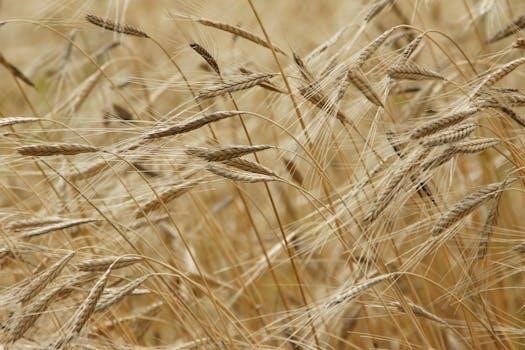
a golden guide hallucinogenic plants
Hallucinogenic plants have fascinated humanity for millennia‚ with their usage deeply embedded in various cultures․ Early humans encountered these plants‚ experiencing profound effects․ Their use spans from ancient religious purposes to healing traditions‚ captivating both general readers and specialists․
What are Hallucinogenic Plants?
Hallucinogenic plants are a diverse group of botanical species that contain psychoactive compounds capable of altering perception‚ mood‚ and cognition․ These plants‚ sometimes referred to as psychoactive plants‚ induce changes in the nervous system‚ leading to altered states of consciousness․ Throughout history‚ humans have encountered these plants‚ some of which provided nourishment‚ others cured illnesses‚ and some‚ surprisingly‚ evoked profound shifts in awareness․ They contain unique chemicals that interact with brain receptors‚ causing visual‚ auditory‚ and tactile hallucinations‚ as well as altered thought patterns and emotional experiences․ These alterations can range from mild distortions to intense‚ transformative experiences‚ often perceived as journeys into other worlds․ Their chemical makeup can include substances such as mescaline‚ psilocybin‚ and beta-carbolines‚ among others․
Historical and Cultural Significance
The historical and cultural significance of hallucinogenic plants is profound‚ dating back to ancient times․ Initially‚ these plants were primarily used for religious and spiritual purposes‚ often considered sacred and integral to rituals․ Archeological evidence‚ such as pipes made of cougar bones from around 2000 BC‚ attests to their early use․ In many cultures‚ hallucinogenic plants served as a gateway to altered states of consciousness‚ believed to facilitate communication with the spiritual realm‚ provide healing‚ and enhance personal development․ They were used in shamanic practices and communal ceremonies‚ where individuals would embark on collective journeys into the unconscious․ These practices‚ deeply embedded in societal structures‚ highlight the plants’ significant role in shaping cultural beliefs and traditions․ Their use is an important aspect of cultural exploration․

Specific Hallucinogenic Plants
This section explores specific hallucinogenic plants like Peyote‚ Salvia Divinorum‚ and Ayahuasca․ Each plant has unique properties and cultural uses․ We will delve into their effects and historical background․
Peyote⁚ Ritual Use and Effects
Peyote‚ a small‚ spineless cactus‚ holds significant cultural importance‚ particularly for Native American tribes who employ it in sacred rituals․ The mescaline within peyote induces profound hallucinogenic experiences‚ often described as spiritual journeys that promote morality and ethical behavior․ Unlike many other substances‚ peyote is not considered addictive․ Its ritualistic use is deeply entwined with traditions‚ facilitating a connection to the divine and promoting collective consciousness․ The effects of peyote are known to vary significantly depending on individual physiology and dosage․ While some users report enhanced perception‚ others may experience introspection and intense emotional reactions․ The use of peyote is a communal experience within the context of Native American religious practices․
Salvia Divinorum⁚ Popularity and Potency
Salvia divinorum‚ a member of the mint family‚ has garnered significant attention due to its powerful psychoactive effects․ Native to Mexico‚ this herb is known for its potent kappa receptor agonist properties‚ leading to intense‚ short-lived hallucinogenic experiences․ Unlike other traditional hallucinogens‚ Salvia is not associated with serotonergic pathways‚ resulting in unique effects․ Its increasing popularity has been fueled partly by media attention․ The plant’s potency is a critical consideration‚ as even small doses can induce profound alterations in perception and consciousness․ While some users seek its effects for self-exploration‚ others may find the experience disorienting and overwhelming․ Due to its strong effects‚ Salvia divinorum is often approached with caution‚ and its use can be unpredictable․
Ayahuasca⁚ Beta-carbolines and MAO-A Inhibition
Ayahuasca‚ a traditional Amazonian brew‚ is characterized by its complex combination of plants‚ notably those containing beta-carbolines․ These compounds act as reversible MAO-A inhibitors‚ crucial to the psychoactive experience․ The inhibition of MAO-A allows the active hallucinogen‚ DMT‚ to become orally active․ Normally‚ DMT is rapidly metabolized by MAO-A enzymes in the gut‚ but the beta-carbolines prevent this process․ The resulting effects are profound‚ often described as intense spiritual journeys․ The harmala alkaloids‚ also present‚ contribute to the overall experience․ It’s important to note that while the beta-carbolines themselves have mild hallucinogenic properties at higher doses‚ their primary role is to enable DMT’s activity․ This synergistic interaction of compounds is what distinguishes Ayahuasca’s unique psychoactive effects․ The ritualistic context of its use is also a critical aspect of its overall impact․

Hallucinogenic Plants in Different Cultures
The use of hallucinogenic plants varies significantly across cultures‚ deeply interwoven with spiritual and ritual practices; These plants are often central to collective journeys into the unconscious‚ as well as healing traditions․
Use in Native American Rituals
Native American cultures have a long and profound history of utilizing hallucinogenic plants within their sacred rituals․ These plants are not merely seen as substances that alter perception‚ but rather as powerful tools for spiritual growth‚ healing‚ and connection with the divine․ Peyote‚ for example‚ is a central element in many Native American ceremonies‚ believed to promote morality and ethical behavior among its users․ The ceremonial use of these plants often involves a collective journey into the unconscious‚ guided by experienced practitioners․ These rituals are deeply rooted in tradition‚ passed down through generations‚ and are integral to the cultural and spiritual identity of many tribes․ The plants facilitate a profound experience that transcends the ordinary‚ allowing participants to access deeper realms of consciousness and understanding․ The use is often carefully regulated within the community‚ with a strong emphasis on respect‚ intention‚ and the sacredness of the experience․
Shamanic Rites and Plant-Based Journeys
Shamanic practices worldwide have long incorporated hallucinogenic plants as key elements in their rites‚ using them to facilitate journeys into altered states of consciousness․ These plant-based journeys are not viewed as mere recreational trips‚ but rather as vital means for spiritual exploration‚ healing‚ and divination․ Shamans‚ acting as intermediaries between the human and spirit worlds‚ utilize these plants to access insights‚ communicate with ancestors‚ and perform healing rituals․ The psychoactive properties of these plants are believed to open pathways to other realities‚ allowing shamans to diagnose illnesses‚ restore balance‚ and gain knowledge crucial for the well-being of their communities․ These journeys are deeply personal and transformative‚ often involving visions‚ encounters with spiritual entities‚ and profound revelations about the nature of existence․ The use of these plants is approached with great reverence and understanding of their power‚ guided by traditions passed down through generations․

Practical Aspects and Safety
Understanding the practicalities‚ from cultivation to legal implications‚ is crucial when dealing with psychoactive flora․ Safety measures and risk awareness are paramount‚ as well as the benefits and responsible usage of hallucinogenic plants․
Cultivation and Propagation of Psychoactive Plants
The cultivation and propagation of psychoactive plants is a nuanced endeavor‚ often requiring specific environmental conditions and knowledge․ Understanding the natural habitats of these plants is essential for successful cultivation‚ from soil composition to light requirements․ Many psychoactive plants‚ such as Psychotria viridis‚ can be propagated from seeds or cuttings‚ each method demanding particular techniques․ The process involves careful attention to temperature‚ humidity‚ and nutrient levels‚ mimicking their native environments․ Some plants‚ like certain cacti‚ might require special care during different growth stages․ Furthermore‚ legal restrictions often influence cultivation practices‚ necessitating adherence to regulations․ Therefore‚ a detailed understanding of both botanical needs and legal frameworks is vital for those interested in growing these plants for personal or research purposes․ The complexity of propagation varies greatly‚ making detailed guides very important․
Legality and Regulation of Hallucinogenic Plants
The legality and regulation of hallucinogenic plants vary significantly across the globe‚ ranging from complete prohibition to regulated use and cultivation․ Many countries classify these plants as controlled substances‚ making their possession‚ sale‚ and cultivation illegal․ However‚ some regions have specific exemptions for traditional religious or cultural practices‚ while others are exploring decriminalization․ The legal status of plants such as peyote‚ salvia divinorum‚ and ayahuasca can differ drastically from one jurisdiction to another․ Understanding local and international laws is crucial before engaging in any activity involving these plants․ The evolving legal landscape also reflects ongoing debates about personal freedoms‚ public health concerns‚ and the cultural significance of psychoactive substances․ Therefore‚ it is essential to stay informed about the current legislation in your area․
Risks and Benefits of Hallucinogen Use
The use of hallucinogenic plants presents a complex interplay of potential risks and benefits‚ necessitating careful consideration․ Risks can include psychological distress‚ such as anxiety‚ paranoia‚ or triggering latent mental health issues‚ particularly in individuals with predispositions․ Furthermore‚ the unpredictable nature of these substances can lead to accidents or impaired judgment․ However‚ some proponents highlight benefits such as spiritual insights‚ personal growth‚ and therapeutic potential for conditions like depression and PTSD․ The effects of hallucinogens are also highly dependent on dosage‚ individual sensitivity‚ and the setting of use․ The risks are amplified when substances are used without proper preparation‚ knowledge‚ and guidance․ Therefore‚ responsible and informed usage is essential‚ ideally involving expert supervision and a supportive environment․

Resources and Further Reading
Numerous resources exist for those seeking more knowledge on hallucinogenic plants‚ including key guides‚ ethnobotanical studies‚ and online archives like Erowid‚ offering comprehensive information for both general readers and specialists․
Key Guides and Publications
Several key publications serve as valuable resources for understanding hallucinogenic plants․ Among the most notable is “A Golden Guide to Hallucinogenic Plants‚” by Richard Evans Schultes‚ which provides an accessible overview of the role of psychoactive plants in human societies․ This guide‚ though out of print‚ remains a foundational text‚ surveying usage from ancient times to the present․ Another important work is “Plants of the Gods” by Schultes‚ Hofmann‚ and Rätsch‚ exploring the sacred‚ healing‚ and hallucinogenic powers of various plants․ These texts often delve into the cultural significance‚ physiological effects‚ and traditional uses of these plants․ For those seeking more in-depth information‚ ethnobotanical studies and specialized publications offer detailed research on specific plants and their properties․ Such resources are crucial for both general readers and those with specialized interests in the field․ Many of these publications are also available online․
Ethnobotanical Studies and Research
Ethnobotanical studies play a crucial role in understanding the complex relationship between humans and hallucinogenic plants․ These studies explore how different cultures utilize indigenous plants‚ including those with psychoactive properties‚ for various purposes such as medicine‚ rituals‚ and spiritual practices․ Research in this field often combines botanical knowledge with anthropological insights‚ documenting traditional uses and preparation methods․ Ethnobotanists examine the cultural significance of these plants‚ focusing on their role in social structures‚ belief systems‚ and healing traditions․ Scientific research also investigates the chemical compounds within these plants‚ seeking to understand their physiological effects and potential therapeutic applications․ This interdisciplinary approach is essential for a comprehensive understanding of hallucinogenic plants‚ moving beyond purely biological aspects to encompass their cultural context․ The knowledge gained through these studies is vital for preserving traditional practices and promoting responsible plant use․

